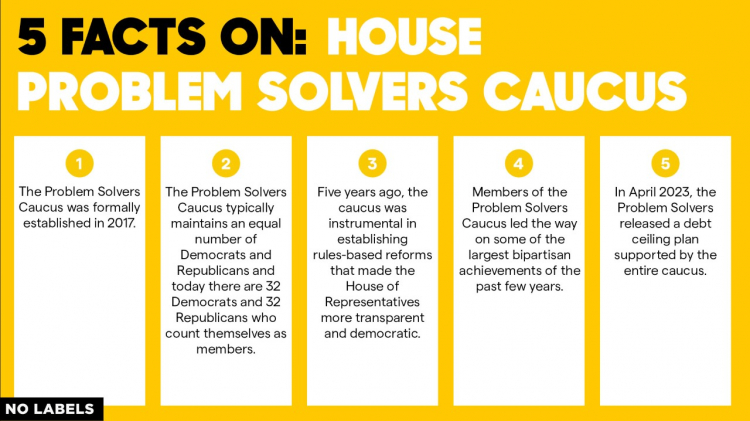Five Facts on the House Problem Solvers Caucus

Last week, the bipartisan House Problem Solvers Caucus unveiled a proposal to help resolve the looming debt ceiling crisis that threatens to derail the U.S. economy. It’s the latest instance of the group making waves by offering legislative ideas that build from the bottom-up with bipartisan consensus. Here are Five Facts about this under-the-radar group that’s made a name for itself in Washington over the last few years:

- The Problem Solvers Caucus was formally established in 2017.
The idea for such a Caucus was first conceived of by No Labels in the early 2010s, which began hosting regular meetings of bipartisan groups of House members. Reps. Josh Gottheimer (D-NJ) and Tom Reed (R-NY) registered the Caucus as a formal member-driven organization six years ago to give rise to the center and counter the growing influence of more partisan political groups in Congress, who were increasingly playing an outsized role in the legislative process despite representing a small percentage of Americans.
- The Problem Solvers Caucus typically maintains an equal number of Democrats and Republicans and today there are 32 Democrats and 32 Republicans who count themselves as members.
Problem Solvers Caucus members join the caucus in pairs, one person from each party, in order to maintain balance. This structure encourages bipartisan dialogue and promotes collaborative problem-solving.
- Five years ago, the caucus was instrumental in establishing rules-based reforms that made the House of Representatives more transparent and democratic.
In 2018, the Problem Solvers Caucus played a significant role in pushing for rules reform in the House of Representatives. They advocated for changes to increase transparency, promote bipartisan legislation, and empower individual members to have a greater influence in lawmaking. Many of these changes were incorporated into the rules package for the 116th Congress.
- Members of the Problem Solvers Caucus led the way on some of the largest bipartisan achievements of the past few years.
The caucus has successfully helped pass a variety of legislative initiatives, including the framework that became the landmark 2021 bipartisan infrastructure law. Just last year members of the Problem Solvers Caucus played a major role in passing the first major gun safety law in 30 years along with a law to create jobs and protect America’s security by manufacturing more computer chips on U.S. soil.
- In April 2023, the Problem Solvers released a debt ceiling framework supported by the entire 64-person caucus.
The Problem Solvers’ framework for addressing the debt ceiling crisis has four key features. One, suspend the debt ceiling until the conclusion of 2023, providing an opportunity to initiate a strategy for slowing government spending. Two, set up an independent commission tasked with producing recommendations for managing the United States' long-term debt and deficit issues, while also mandating a congressional vote on the proposed plan. Three, implement new controls on the 2024 budget to stabilize the deficit in the short-term and require Congress to pass its budgets and spending bills under “regular order,” meaning that they must go through the full committee markup process rather than be thrown together at the last minute. Four, require the Government Accountability Office to annually publish a "fiscal state of the nation" report, and for the president to issue an annual mid-year budget report.
No Labels is an organization of Democrats, Republicans, and independents working to bring American leaders together to solve problems.





